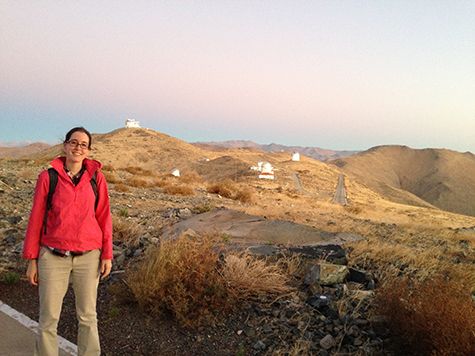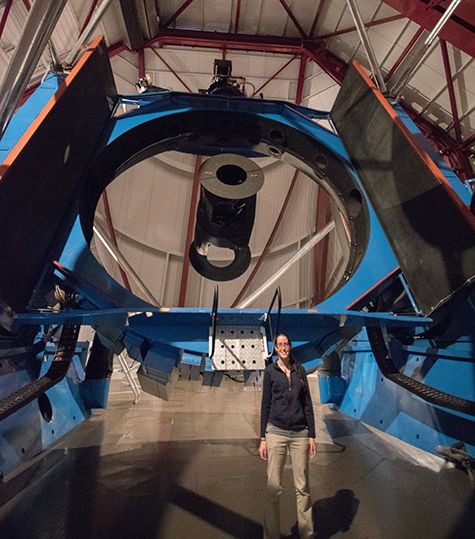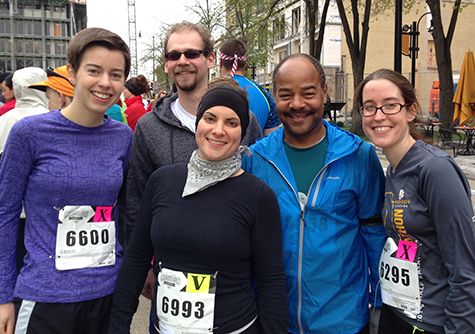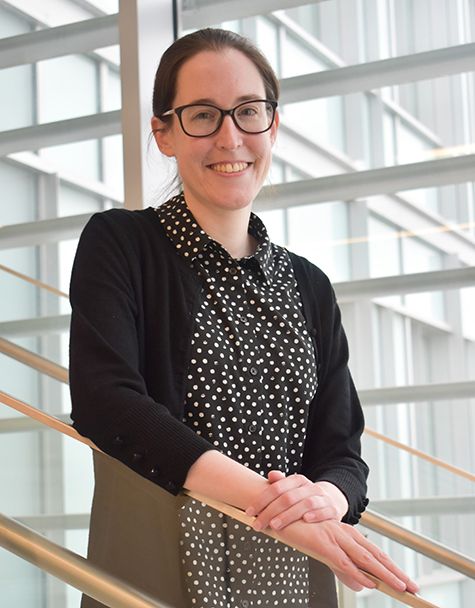Early Career Scientist Spotlight
Dr. Erin Boettcher (she/her/hers)
Observational Astronomer
X-ray Astrophysics Laboratory (662)
Did you always know that you wanted to be an observational astronomer?
I’ve always been fascinated by the physical world and have had a desire to understand the what, where, why, and how of the way things work. When I was young, my family often visited science and natural history museums, and a lot of different areas of science sparked my imagination - first paleontology, and later marine biology and astronomy. Astronomy was particularly interesting to me because it addresses some of the most fundamental questions - how did we get here, where are we going, and are we alone?
It wasn’t until I was in college that I began to understand more about the nature of observational astronomy research. I was fascinated by the idea that we can learn about the formation and evolution of the universe by studying faint signals that have been traveling to us for millions or billions of years. As an undergrad at Haverford College, I was introduced to the research process in a hands-on way in Prof. Beth Willman’s courses, where I had the opportunity to observe using research-class telescopes for the first time. We learned the fundamentals of planning an observing run, writing code to analyze the data, and interpreting the results. A research project that I began in one of Prof. Willman’s courses turned into my first publication, and I discovered that I loved the day-to-day process of astronomical research. I knew then that pursuing grad school and a career in research was the right path for me.

Credit: Hsiao-Wen Chen
What science questions do you investigate?
I’m interested in how spiral galaxies like our own Milky Way form and evolve over cosmic time. An important process in galaxy evolution is the circulation of gas into and out of galaxies. Galaxies grow by accreting gas from their environments and turning that gas into stars. As new stars are born, the most massive stars impart energy to the gas around them through stellar winds and supernovae explosions, heating the gas and in some cases ejecting it from the galaxy. Since stars form out of cold gas, heating and ejecting gas from a galaxy suppresses the galaxy’s star-formation rate, affecting how quickly it grows and whether it continues to form stars or becomes quiescent.
I study the physical processes - known as stellar “feedback” - that eject gas from galaxies due to star formation. Some of the questions that we would like to answer include:
- How efficient is stellar feedback at removing gas from galaxies (i.e., how much gas leaves the galaxy per unit of star formation?)?
- Is the gas leaving the galaxy primarily in a hot phase, or is a significant amount of gas ejected in a cold, dense phase as well?
- Under what conditions do ejected gas clouds fall back onto the galaxy, and when are they able to escape into the intergalactic medium?
How did you end up working at NASA Goddard?
I came to NASA Goddard as a postdoctoral researcher in 2021 to work with Dr. Edmund Hodges-Kluck and the X-ray Astrophysics Lab. I was interested in expanding my research in a new direction by studying the hot gas in and around galaxies using X-ray observations. My research had previously focused on optical and ultraviolet observations, which are sensitive to cool gas; however, much of the gas around galaxies (known as the circumgalactic medium) is in a hot (million degree) phase that is detectable only in the X-ray regime. I’m excited about synergies between optical, ultraviolet, and X-ray observations of the circumgalactic medium for better understanding the multi-phase nature of the gaseous environments of galaxies. Being in the X-ray Astrophysics Lab at NASA Goddard Space Flight Center (GSFC) has been an excellent opportunity to be introduced to a new wavelength regime by experts in the field while continuing to pursue multi-wavelength research.

Credit: Gwen Rudie
What research accomplishment are you most proud of?
I’m proud of a method that I developed as a graduate student to study a phenomenon called a galactic fountain. This “fountain” is a circulation of gas clouds that are ejected from the galaxy disk by stellar feedback and subsequently fall back onto the disk in a fountain-like flow. These fountains may be important for a number of reasons, including potentially fueling star formation by causing hot gas around the galaxy to cool and accrete onto the disk. An open question about these fountain flows is why the layers of gas that they produce around galaxy disks (called extraplanar gas) are much thicker than we expect given the temperature of the gas. My PhD research investigated this question to determine what physical processes are responsible for thickening these extraplanar gas layers.
My work tested the hypothesis that turbulent motions in the extraplanar gas provide the additional dynamical support needed to explain their density distributions. To test this, I needed to measure the motions in the gas perpendicular to the galactic plane, which can only be done in galaxies that are seen face-on. This is challenging to do because the emission that we detect from the extraplanar gas is blended with emission from the underlying disk. I showed that it is possible to separate the planar and extraplanar signals in optical spectroscopy and reliably recover the properties of the extraplanar gas. This allowed us to determine that the extraplanar gas is indeed quite turbulent and that the turbulent motions can explain the thickness of the gas layers. You can check out the paper that we published on this here. We are now applying this technique to galaxies with a range of masses and star-formation rates to better understand how the star-formation activity in galaxies shapes the properties of galactic fountains.
Where do you see yourself in the near future?
I’m excited to expand my current research program into the X-ray regime to delve deeper into the relationship between the hot and cool gas in galactic fountains and winds. I’ll be working with early data from the X-Ray Imaging and Spectroscopy Mission (XRISM), a new X-ray telescope led by the Japan Aerospace Exploration Agency and NASA that is scheduled for launch in 2023. The launch of XRISM will make the next few years a busy and exciting time and an opportunity to learn new skills in X-ray data analysis and interpretation. In the longer term, I’m interested in a career path that allows me to primarily pursue research while working with students at the undergraduate and graduate level.
What keeps you inspired by your work?
I feel lucky to be surrounded by creative and motivated people whose ideas inspire me on a daily basis. I enjoy being in the dynamic environment that GSFC offers; it’s motivating to hear about how other people are tackling diverse and challenging science questions that are different from the questions I think about on a daily basis. At GSFC, I’ve also appreciated having a behind-the-scenes perspective on how space-based observatories are realized, from the proposal of a mission concept through to launch. As an observational astronomer using both space- and ground-based observing facilities, I have a new appreciation for the teams that make these facilities possible, and I want to make the most of every photon that I detect and the clues that they have to offer about the physical processes in the universe.
I’m also inspired by working with students and participating in public outreach. I’ve enjoyed volunteering for public observing nights and events at planetariums throughout my career, and it’s always rewarding to chat with people with a broad range of exposure to astronomy and to science in general. Experiencing the wonder that so many people bring to seeing Jupiter’s moons through a telescope or hearing about black holes reminds me how fortunate my colleagues and I are to be able to think about awe-inspiring questions on a daily basis.

Credit: A friendly passerby
What do you like to do in your free time?
The area around GSFC has a lot of green space, and I enjoy being outside and in nature. A number of my family and friends like to run marathons and half-marathons recreationally, and they’ve gotten me into running and training for the occasional race. It’s been a fun way to get outside and push myself in ways that are very different from what I do professionally. I also enjoy watching soccer and basketball and like to go to the theater (particularly musical theater) when I have the chance.
Biography
Home Town: East Lyme, CT, USA
Undergraduate Degree:
B.S. Astrophysics, Haverford College, Haverford, PA
Post-graduate Degrees:
Ph.D. Astronomy, University of Wisconsin - Madison, Madison, WI

Link to Dr. Boettcher's GSFC Bio
